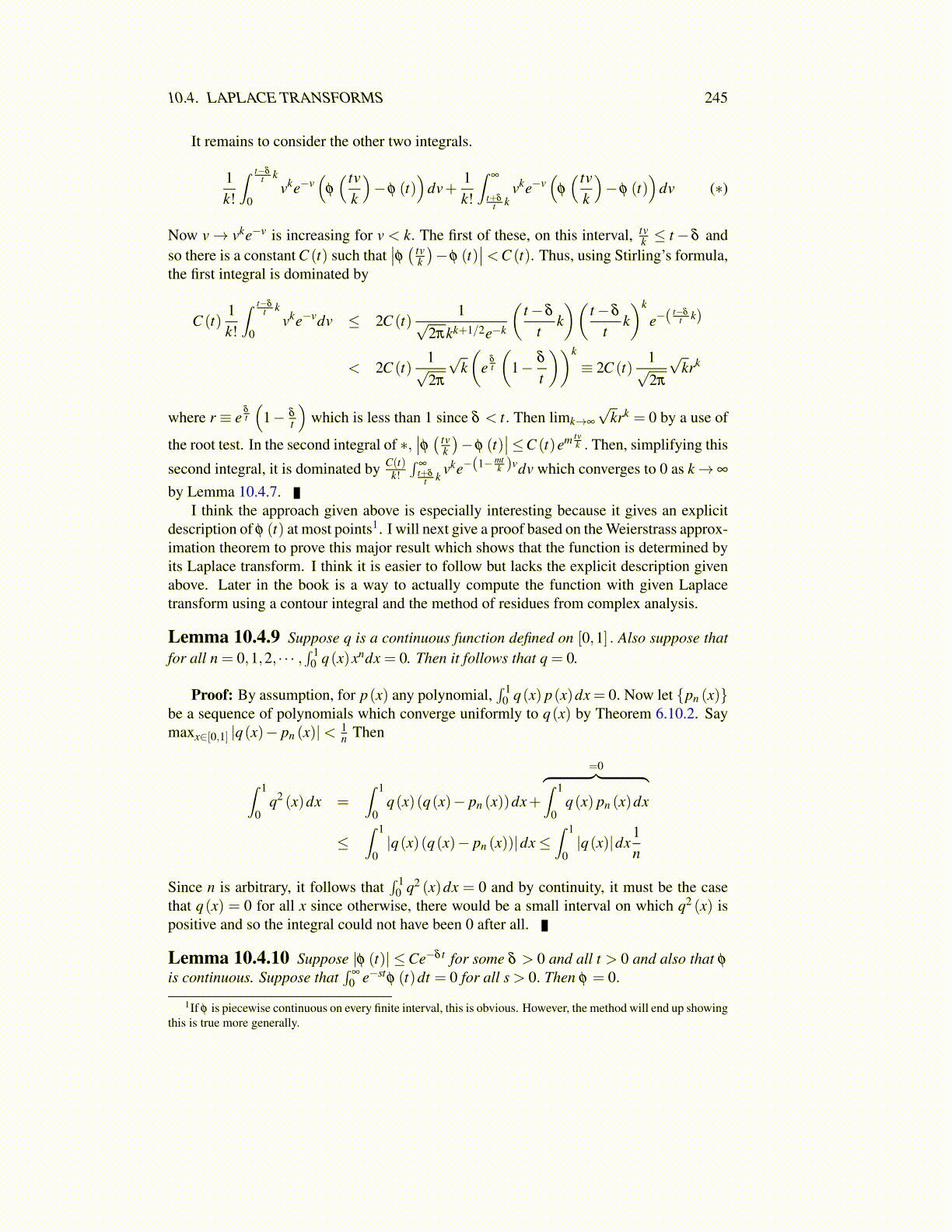
10.5. EXERCISES 245
2. Find Γ( 1
2
). Hint: Γ
( 12
)≡∫
∞
0 e−tt−1/2dt. Explain why this equals 2∫
∞
0 e−u2du. Then
use Problem 49 on Page 224 or Theorem 9.9.5. Find a formula for Γ( 3
2
),Γ( 5
2
), etc.
3. For p,q > 0, B(p,q) ≡∫ 1
0 xp−1(1− x)q−1dx. This is called the beta function. ShowΓ(p)Γ(q) = B(p,q)Γ(p+ q). Hint: You might want to adapt and use the Fubinitheorem presented earlier in Theorem 9.9.4 on Page 214 about iterated integrals.
4. Verify that L (sin(t)) = 11+s2 .
5. Show directly that∫
∞
0sinx
x dx exists. Hint: For large R and small ε, consider∫ R
ε
sin tt
dt =∫
π/2
ε
sin tt
dt +∫ R
π/2
sin tt
dt
and show that the limit of the first as ε → 0 exists and the limit of the second asR→ ∞ also exists. Hint: The second integral is
−cos tt|Rπ/2−
∫ R
π/2
cos tt2 dt =
−cos(R)R
−∫ R
π/2
cos tt2 dt
Then t→ cos tt2 is in L1
(π
2 ,∞)
so the limit exists as R→ ∞. Why? Then the first term
on the right converges to 0 as R→ ∞. Now consider∫
π/2ε
sin tt dt. Explain why the
integrand is positive and bounded above by 1/√
t. Then compare with∫
π/2ε
1√x dx =
2√
π/2−2√
ε . Argue that
limε→0+
∫π/2
ε
sin tt
dt = sup{∫
π/2
ε
sin tt
dt : 0 < ε < π/2}≤ 2√
π/2.
6. For s≥ 0, define F (s)≡∫
∞
0 e−sx sinxx dx. Thus
F (0)−F (s) = limR→∞
∫ R
0
(1− e−sx) sinx
xdx.
Show lims→0+ F (s) = F (0). Hint: You might try to justify the following steps orsomething similar.
|F (0)−F (s)| ≤∣∣∣∣∫ M
0
(1− e−st)∣∣∣∣+ ∣∣∣−cos t
t|∞M∣∣∣+ ∣∣∣∣∫ ∞
M
1t2 dt
∣∣∣∣≤
∣∣∣∣∫ M
0
(1− e−st)∣∣∣∣+ 1
M+
1M
Now pick M very large and then when it is chosen in an auspicious manner, lets→ 0+ and show the first term on the right converges to 0 as this happens.
7. It was shown that L (sin(t)) = 11+s2 . Show that it makes sense to take L
( sin tt
).
Show that∫
∞
0sin(t)
t e−stdt = π
2 −∫ s
01
1+u2 du. To do this, let F (s) =∫
∞
0sin(t)
t e−stdt andshow using Theorem 10.3.5 that F ′ (s) = − 1
1+s2 so F (s) = −arctan(s)+C. Thenargue that as s→ ∞,F (s)→ 0. Use this to determine C. Then when you have donethis, you will have an interesting formula valid for all positive s. To finish it, let s= 0.From Problem 6 F (0) = lims→0+ F (s) , this gives
∫∞
0sinx
x dx, the Dirichlet integral.Another derivation is given earlier in the chapter.